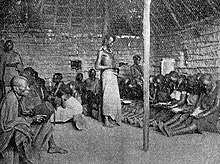Digo people
 Image of Digo People by the Mercy and Truth, A record of C.M.S. Medical Mission work early 20th Century. | |
| Regions with significant populations | |
|---|---|
| 409,595[1] | |
| 100,000+[2] | |
| Languages | |
| Digo | |
| Religion | |
| Majority: Islam Minority: African Traditional Religion | |
| Related ethnic groups | |
| Mijikenda, other Bantu peoples | |
The Digo (Wadigo in Swahili) are a Bantu ethnic and linguistic group based near the Indian Ocean coast between Mombasa in southern Kenya and northern Tanga in Tanzania. In 1994 the Digo population was estimated to total 305,000, with 217,000 ethnic Digo living in Kenya and 88,000 (1987 estimate) in Tanzania.[3] Digo people, nearly all Muslims,[4] speak the Digo language, called Chidigo by speakers, a Bantu language. They are part of the greater Mijikenda ethnic group of people which contains nine smaller groups or tribes, including the Duruma, Giriama, and others.[citation needed]. The Digo in Tanzania are the native inhabitants of Mkinga and Tanga districts of Tanga Region and are a major cultural group there.
Culture
Due to the growing influence of Swahili culture, some Digo began converting to Islam in the 19th century. Islam soon spread further among the Digo and the majority were Muslim by the 1940s.[5]
References
- ^ "2019 Kenya Population and Housing Census Volume IV: Distribution of Population by Socio-Economic Characteristics". Kenya National Bureau of Statistics. Retrieved 24 March 2020.
- ^ "Digo Tribe I Tanga Guide » Tanzania Travel Guide". Tanzania Travel Guide. Retrieved 2021-07-16.
- ^ "Chidigo". Ethnologue. 1999-02-19. Retrieved 2015-11-13.
- ^ Project, Joshua. "Mijikenda, Digo in Kenya". joshuaproject.net. Retrieved 2020-09-07.
- ^ Brenner, Louis (1993). Muslim Identity and Social Change in Sub-Saharan Africa. Indiana University Press. pp. 198–199. ISBN 978-0-253-31269-3.
